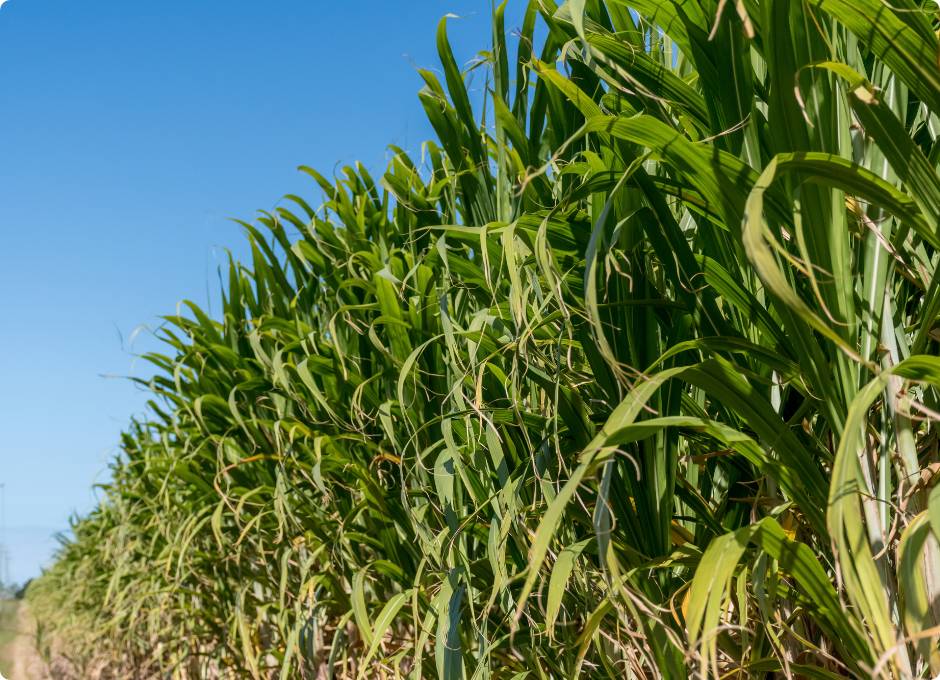Understanding the Biofuel Industry
The Blue Biofuels’ Guide to the Biofuel Industry
The green revolution is here — and the fuel industry must evolve in order to meet the worldwide demand for sustainably harvested biofuel.
Powered by our vision of a transformed biofuel industry, Blue Biofuels developed a patented process that allows us to convert plants into ethanol for transportation and aviation.
This innovative process turns cellulose into sugars for use in widely available, industry standard fermentation into bioethanol.

What is biofuel?
Put simply, it’s a fuel derived from any living matter, such as plants or animal fats.
Blue Biofuels sources cellulosic biomass — such as king grass and sugarcane bagasse — as our feedstock. We then use the CTS (cellulose-to-sugar) process to turn this biomass into its base components of sugar and lignin, and then convert the sugars into bioethanol.
Once we convert our biomass into ethanol, we can then use the Vertimass Process to transform it into sustainable aviation fuel (SAF).
First-generation biofuels are produced from biomass often used for food, such as corn and soy. As well-established technology, corn-based ethanol is the most common in the United States — for now.
Our Three Pillars
Blue Biofuels builds climate-friendly solutions for the fuel industry through three distinct pillars:
More than 50 billion tons of land-based biomass grow on the earth each year. Nature stores energy in the form of biomass. We call biomass nature’s battery. If this biomass is not used, it will eventually decompose.
Uniquely, Blue Biofuels uses our patented CTS process to convert the cellulosic portion of virtually any biomass material into biofuel to meet the growing needs for a sustainable, low carbon transportation fuel. The feedstocks we source for our CTS process are abundant, inexpensive options compared to corn, the most common raw plant material currently used for first-generation biofuel in the United States.
It’s estimated that 5 billion tons of biomass can be harvested globally each year without any negative environmental impact — and converted into 500 billion gallons of ethanol.
As fossil fuels increase in cost and climate change concerns continue, biofuels offer a solution. They burn cleaner than fossil fuels — and can be produced from renewable, abundantly available resources.
More importantly for the United States, they fill the requirement placed on the biofuel industry by the Renewable Fuel Standard, a policy that demands that transportation fuel contain a minimum volume of renewable fuel each year.
What is the Renewable Fuel Standard and how is it measured?
Congress created the Renewable Fuel Standard to reduce greenhouse gas emissions and decrease reliance on imported oil.
In order to track compliance, the program implemented environmental credits, called Renewable Identification Numbers (RINs).
RINs ensure regulated oil companies meet the conditions outlined in the Renewable Fuel Standard listing the necessary blended amounts for ethanol.
But for biofuel companies, like Blue Biofuels, RINs hold a value similar to currency.
Renewable fuels fall into four categories:
- Cellulosic biofuel (D3): Produced from cellulose, and must meet a 60% lifecycle greenhouse gas reduction. This is where Blue Biofuels focuses.
- Advanced biofuel (D5): Produced from non-corn starch, renewable biomass
- Biodiesel (D4): Biomass-based diesel
- Corn-based ethanol (D6): Ethanol produced by corn, and must meet a 20% lifecycle greenhouse gas reduction.
The biggest difference between corn-based ethanol and cellulosic biofuel is the amount of greenhouse gas reduction required by the Environmental Protection Agency to meet the Renewable Fuel Standards.
What does this mean for Blue Biofuels?
The Environmental Protection Agency can adjust annual Renewable Fuel Standard requirements — if needed.
Consistently, cellulosic biofuels fail to meet the demand due to a lack of supply. As a result, the EPA lowers the amount required.
When Blue Biofuels produces a gallon of renewable cellulosic biofuel, it generates a RIN. Refiners obtain these RINs when they purchase and blend the renewable fuel — and then they turn them into the EPA to show compliance.
Cellulosic biofuel (D3) nests under the Advanced Biofuel (D5) RIN, and further under the Renewable Fuel (D6) category, which means excess cellulosic biofuel can be used to meet advanced and total renewable fuel requirements.
Blue Biofuels offers a patented, scalable technology that can help meet these growing demands outlined by the Renewable Fuel Standard. The revolution all starts with shaking up our feedstock sources and implementing our reimagined CTS process.
And we must begin now. If we change the fuel, we change the future.
The RIN Lifecycle
The Renewable Incentive Number (RIN) life cycle. The bioethanol plant produces ethanol, and the RIN is generated and attached to this fuel. The Petroleum refinery produces gasoline at which time a Renewable Volume Obligation (RVO) is incurred. The blender mixes the bioethanol and gasoline at which time the RIN is separated from the ethanol and the blended fuel is sent to the gasoline station for consumption. The separated RIN and RVO meet at the EPA where the RVO is satisfied and the RIN is retired.
